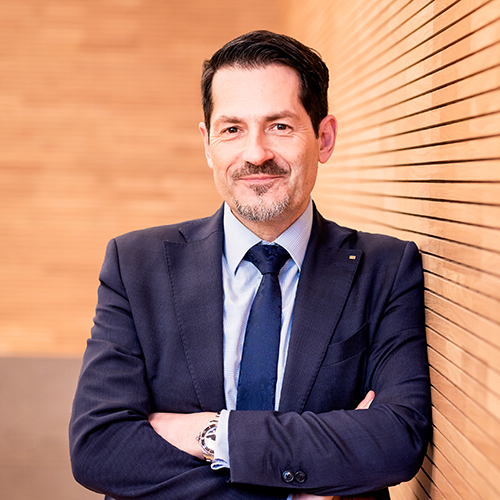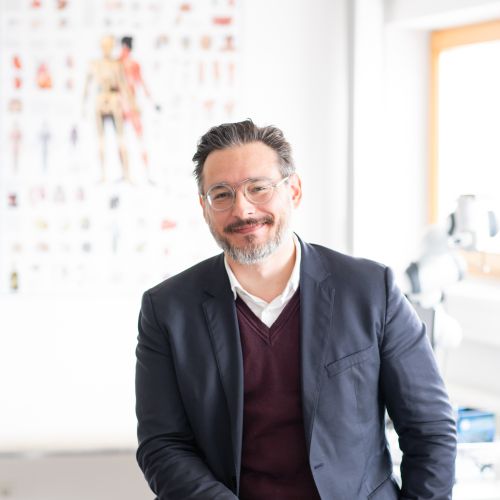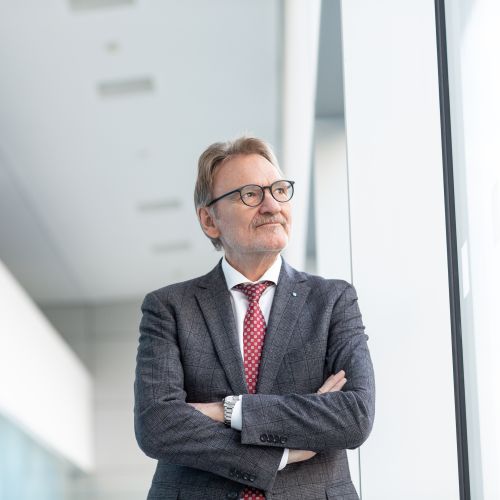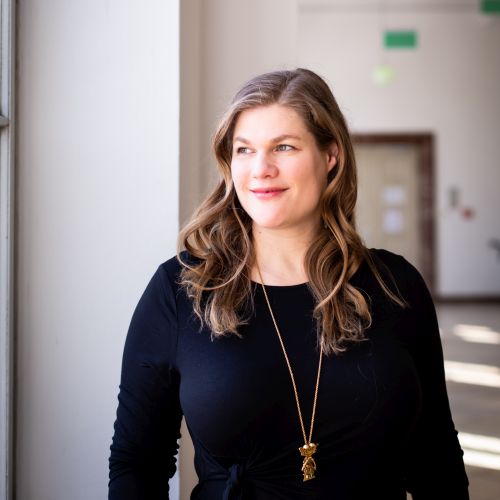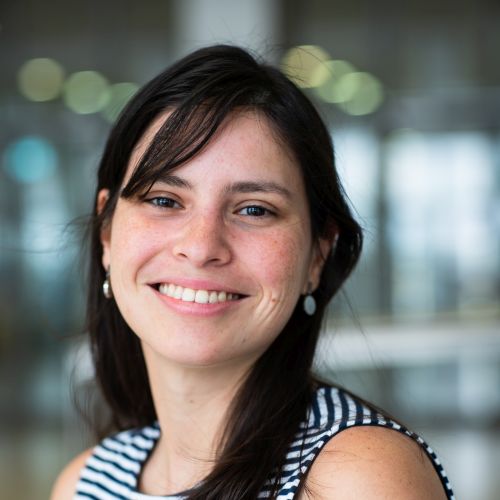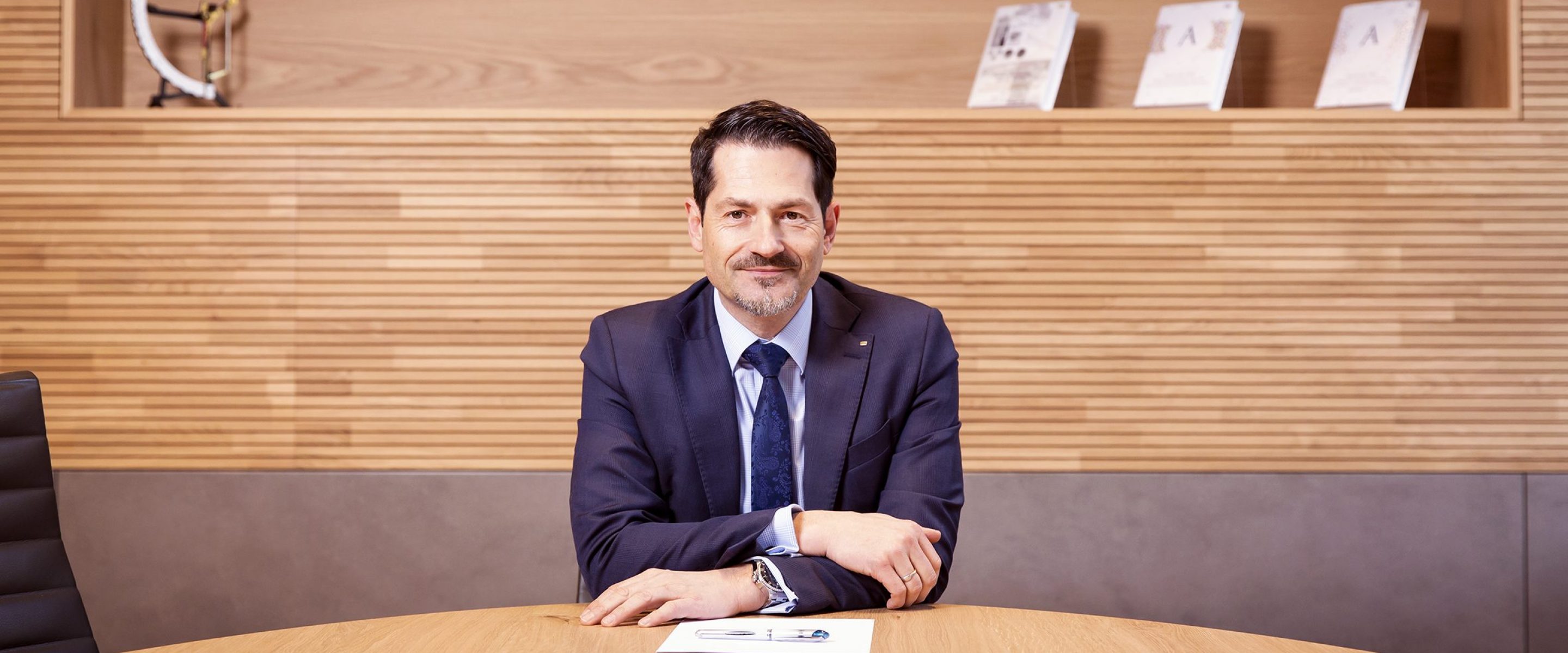
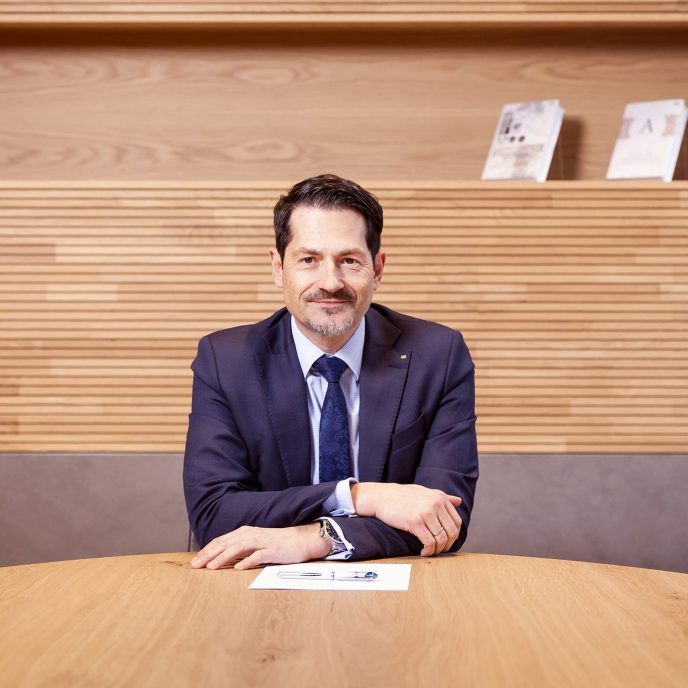
TUM President Thomas F. Hofmann invites you
„Engineers are shaping the future“
The KontakTUM Round Table
Picture: Magdalena Jooss / TUM
An ultra-fast transport pod that nobody wants to get into. A power plant whose electricity nobody buys. A robot nurse that nobody trusts. Nowadays, our engineers are able to develop the most exciting of innovations, but if no one wants them, they are pretty much useless. That is why it is important to think about whether or not – and how – each new technology can be introduced in a socially acceptable way.
For the Round Table on Engineers for the Future, TUM President Thomas F. Hofmann invited four alumni who are deeply involved with this issue on a daily basis – whether it is as a globally recognized researcher in Robotics, as an entrepreneur, as President of VDI – The Association of German Engineers, or as a doctoral student in the Hyperloop research program. They talk about how they personally experience social responsibility as engineers, how creative thinking can be promoted and why diversity plays a key role here.
Good afternoon Mr. President, nice to have you here. Where have you just been?
Prof. Dr. Thomas F. Hofmann
In another Zoom meeting (laughs). At the moment, one online meeting is chasing the next. The digital daily schedule is intense and exhausting. I miss the personal exchange face to face. That’ s why it was nice to see my Vice Presidents in person again recently. In the process, we realized that for weeks we had only been exchanging information digitally.
During your inaugural speech in October 2019, you emphasized the importance you place on engaging directly with all university members.
Thomas F. Hofmann
Yes, that is something I now really miss. But I’m trying to cover a lot digitally – for example, by holding the TUM Presidential Student Lunch as a virtual event. This is a format in which I meet with our students at lunchtime to discuss their individual visions for the future and their expectations of “their TUM”. Or a meeting like this one, at which I get together with our alumni. This is a source of inspiration, new strength and motivation for me, and is very important to me personally.
Why?
Thomas F. Hofmann
It is the people who make our university successful. This applies to university management just as much as to research, teaching and innovation at TUM. And we have now incorporated this into our mission statement. In line with our missions Responsible Research and Innovation, our research and innovation processes are aligned with the values, needs and expectations of society. We don’t develop innovations just for the sake of technology, but for the benefit of the people and their environment. Human-Centered Engineering is therefore our guiding principle.
How does this impact on the education of engineers in practical terms?
Thomas F. Hofmann
On the way to becoming resourceful engineers, our students will of course still need in-depth specialist knowledge, but they will increasingly need to combine their expertise with that of other disciplines. That’s why we are designing our teaching in a way that allows students to explore how their subject might interact with other disciplines, and to take advantage of exciting opportunities at the interfaces with, for example, Informatics and Medicine.
Professor Dr. Sami Haddadin is joining us. The alumni is one of the world’s leading experts in Robotics and Director of the Munich School of Robotics and Machine Intelligence at TUM, and holds the Chair of Robotics and Systems Intelligence.
Thomas F. Hofmann
Good afternoon, Professor Haddadin. We were just talking about research at the interface of disciplines. You are currently developing a robot assistant for the elderly, which is also able to perform ultrasounds, for example.
Sami Haddadin
Yes, its name is GARMI, it has two arms and can assist elderly people in their everyday activities. It uses artificial senses to learn, for example, how to help them stand up, make meals or clear the table. Also, doctors can communicate with it, connect via video call, make a remote diagnosis and even carry out sensitive rehabilitation interventions using Teletouch.
In the development process, you are working closely with the future users. What does that look like exactly?
Sami Haddadin
Pretty straightforward. We let them interact with the robot. In the beginning, the seniors often approach it with a rather negative attitude, but once they have interacted with the robot assistant for a while, it clicks and we get very good feedback from them. They tell us what they like, what they don’t like so much; and which of their problems we developers may not have thought of at all. As a result, we know exactly what our next step needs to be. In the process, we have gained much more than we initially had expected.
How do you train your research team in order for them to handle this multifaceted input?
Sami Haddadin
The starting point of our innovations is a shared vision, which is the first thing we develop. We use tangible visual storyboards, which we create with the stakeholders, to try to show by way of examples what the benefits of a development will be in the end. When it comes to the actual implementation of the project, we then first need hard-core technical input and progress. This means we need robot developers, electrical engineers, Informatics experts, AI experts and programmers. After that, the non-technical specifications come in: Early on and again and again, the vision is calibrated with the future users. In Geriatronics, we also often work with design prototypes to do this, or even more unconventional methods, such as trying out and testing human-robot interaction in scenarios with people and people in cardboard robot costumes.
“It is us engineers who influence what the future will look like, and for that we need a broad education.”
Prof. Dr. Sami Haddadin
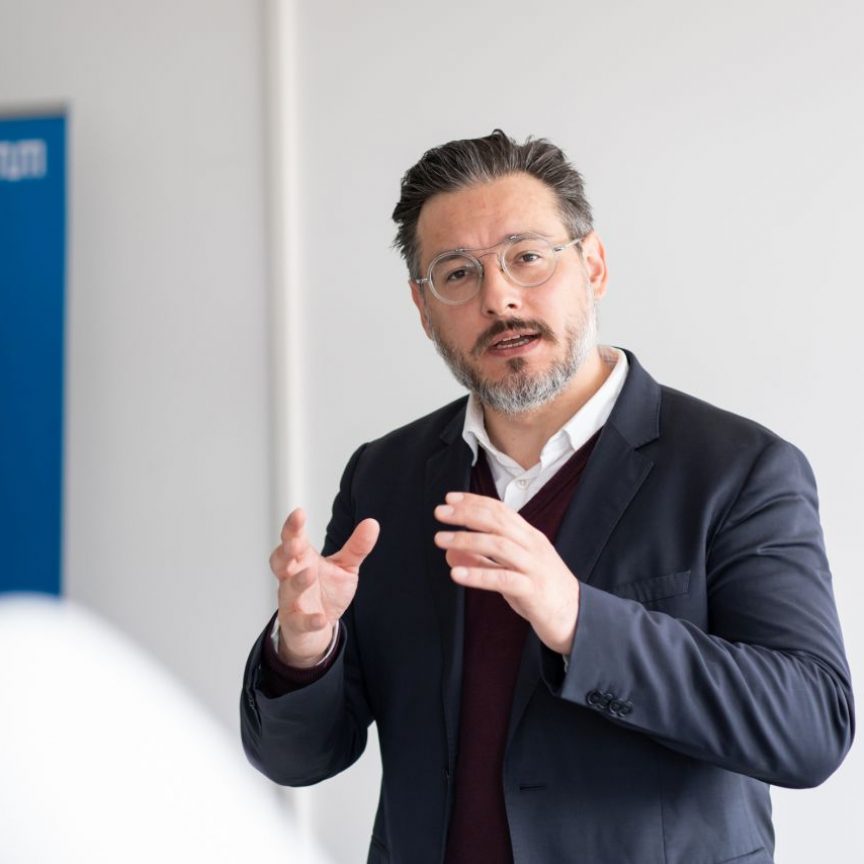
Picture: Magdalena Jooss/ TUM
Sami Haddadin
Perhaps we should first take a step back and look at what an engineer actually is. The term derives from the Latin ingenium, which means creative talent or the ability to invent something meaningful. In my understanding, engineers are the ones shaping the future. And here I include computer scientists, so all scientists involved in developing technology. After all, it’s not as if someone shows up with an idea of what the future should look like, and then we engineers simply make it happen. On the contrary, we are the ones who influence this future, and so in order to be able to do this in the most positive sense of all and for the benefit of people, we need a broad education that includes technical content as well as, for example, philosophical-ethical content.
A philosophical engineer?
Thomas F. Hofmann
Why not? If we are to secure our future as a center of innovation in Germany, it is not enough to tread the well-trodden paths of recent decades over and over again. In the future, engineers will need sociopolitical intuition in addition to their technical expertise, in order to align their innovations with the values, needs and expectations of society.
What exactly would this entail at TUM?
Thomas F. Hofmann
For example: We will replace some of the numerous classroom formats with team projects in which students from different disciplines work together on technological challenges. However, these will not only include their own community of engineers and natural scientists, but will also integrate other disciplines, such as the Humanities and Social Sciences. After all, ethical implications can be better understood by looking at actual research objects in interdisciplinary teams than in theoretical lectures.
Sofía Ramirez is joining the online discussion from Costa Rica. She is visiting family in her home country. The doctoral student is conducting research in TUM’s Hyperloop project: This transport system involves a high-speed train traveling just under the speed of sound in partially evacuated tubes. Sofía Ramirez is in charge of developing the passenger cabin.
Ms. Ramirez, the President has just reported how important team projects are when it comes to training engineers. How did you experience collaboration in the Hyperloop team?
Sofía Ramirez
Our team is the bedrock of our success. Four times in a row, we have built the world’s fastest pod and were able to claim victory in the international competition in California. Before the project, I wouldn’t have guessed what is possible – even within a limited period of time – if everyone pulls together. We love the project and give everything. Let’s not forget, it’s also a lot of fun. Meanwhile, what was once a student project has become a real research program funded by Hightech Agenda Bayern.
The project team is very interdisciplinary in nature.
Sofía Ramirez
Our 85 members are from 29 different countries and a wide range of faculties. We have computer scientists, physicists, electrical engineers, mechanical engineers, people from Business Administration and we need all this expertise to build our pod. We need hardware, software, electronics, mechanical engineering. Add to that the people who support us to run the business. All the events, the sponsorship and so on.
“Feasibility, health impacts and sustainability are key aspects of our project.”
Sofía Ramírez Bernini
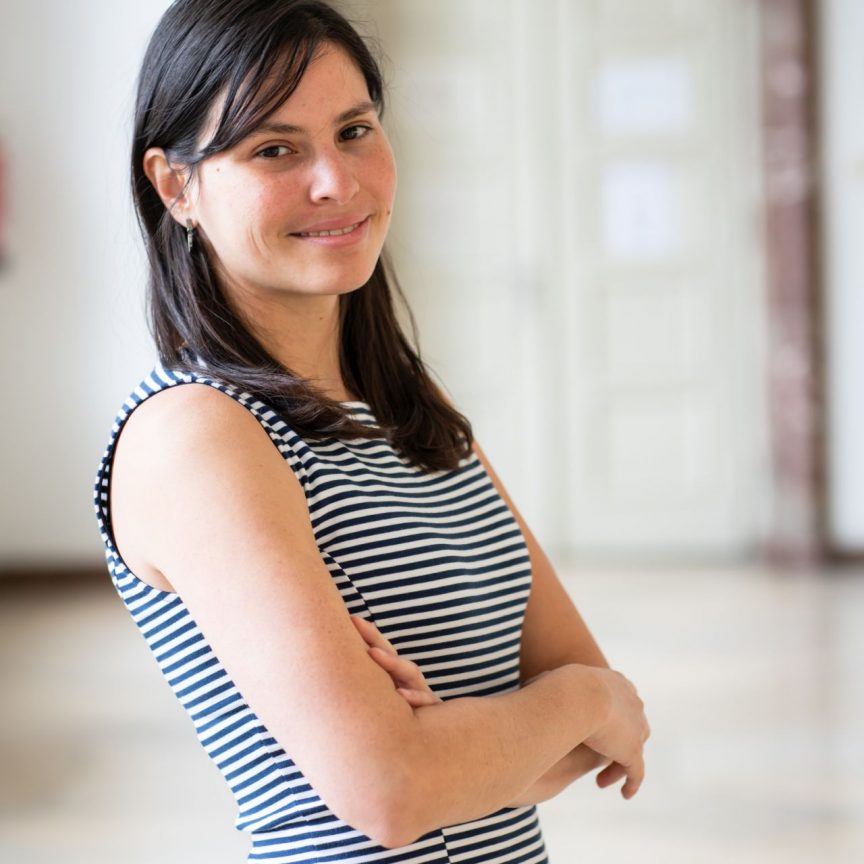
Picture: Magdalena Jooß/TUM
Catharina van Delden
I can only agree to how important an interdisciplinary team can be for a business. My three co-founders and I are all from different faculties, even though we are all from TUM. We have four very different personalities, different perspectives, contrasting approaches. That was often challenging, but today I would say that this interdisciplinarity was the cornerstone of our success.
How so?
Catharina van Delden
For any kind of innovation and unconventional thinking, it is pivotal to be willing to look beyond your own nose, to be open, to make space for new things and to remain curious. Only then can we be truly visionary. I personally get the best ideas when interacting with other people. I love meeting new people, getting to know other people’s perspectives and different ways of life. This helps me to develop my own new ideas. In the same way, our software is helping companies to look beyond their own walls and find people in their environment with whom they have not previously had a business relationship when developing their products and services.
You are supporting companies in incorporating user opinions into product development at an early stage. Why is that important?
Catharina van Delden
A product has to be technically flawless, but above all it should be tailored to the user. If it doesn’t match, people won’t buy it. That’s how the market works. That’s why you need a holistic approach when developing new products, one that doesn’t only consider the technical aspects. You should be asking yourself the question: Why am I doing what I’m doing? For whom am I developing this product?
“Only when we look beyond our own noses can we truly be visionary.”
Catharina van Delden
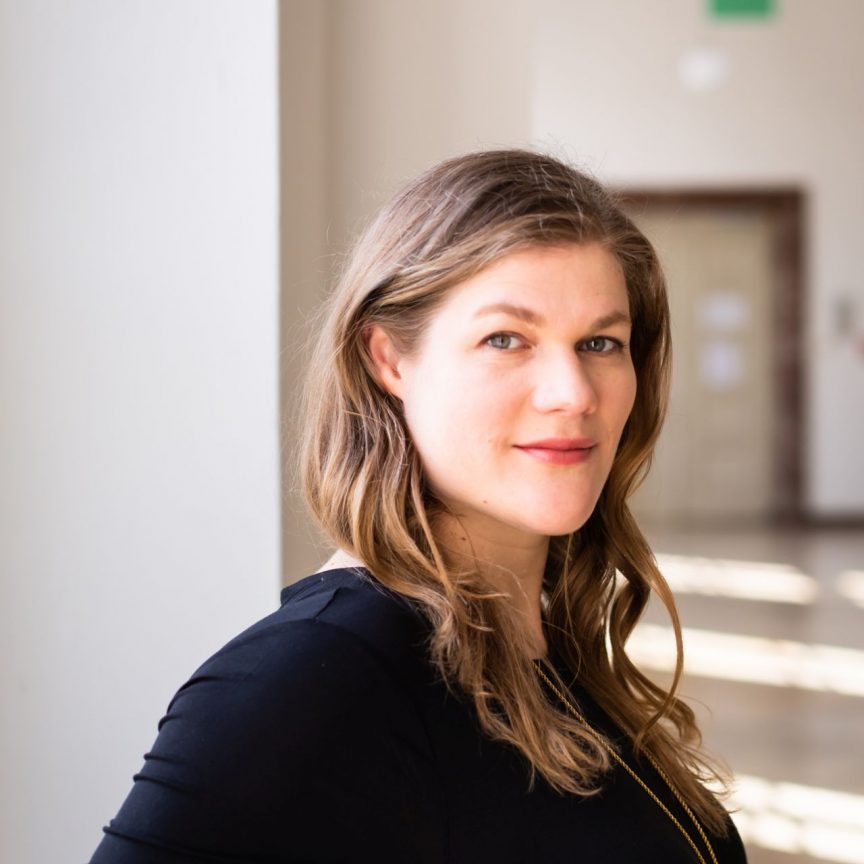
Picture: Magdalena Jooss/ TUM
We are trying to implement something similar in research. In the future, we will need formats along the lines of an expanded process of co-creation. This means integrating the expertise of people outside our university – including that of our alumni – directly into the design process of new technologies, for example, to make them more intuitive and easier to use. This is an outstanding opportunity to let the public participate in processes of innovation. Furthermore, we already have numerous formats for dialogue at TUM that aim to bring scientific research into discourse with society. These events are held, for example, at the TUM Institute for Advanced Study or the Munich Center for Technology in Society.
Our fifth guest is Dr. Volker Kefer. The TUM Alumni holds a doctorate in Mechanical Engineering and has been President of VDI – Association of German Engineers since 2019. Previously, he served as a member of the Board of Management at Deutsche Bahn for several years.
Hello, Dr. Kefer. We were just talking to Ms. van Delden about the fact that a product is actually only any good if it meets someone’s need. What do you think that means with regard to the skills of an engineer?
Volker Kefer
I believe that the technical content of an engineer’s education is key and extremely important. He or she simply has to know what they are doing. Beyond that, however, I see a few additional requirements for engineers that have become much more important recently. I’m talking about a whole range of skills that are necessary to perform certain jobs. For example, jobs that require convincing people, communicating on a large scale, or participating in decision-making processes.
Could you give us an example?
Volker Kefer
I believe that engineers, i.e. people with a technical education, should be on the management boards of large or important companies. But they will only be able to do this job properly if they have an understanding of how to run large companies. In other words, leadership, the communication involved and the ability to develop sound decision-making within a team are just as important as personal integrity, the ability to work under pressure, dealing with stress and so on.
And outside the executive level?
Volker Kefer
If you intend to be a member of any social, public or political body today, you need a lot more than knowledge of technology, because otherwise you won’t be heard. In this context, I always remember the saying: “Not everything that is technically possible is worth striving for or socially desirable.” There are some projects that forced us to realize that social and political acceptance are indeed strong influencing factors. An example here is nuclear power. Society’s rejection of nuclear power and the commitment of engineers have led to the emergence of many alternative approaches to generating power. Time will tell whether these will prevail. In any case, it is not enough to approach these challenges from a technical point of view alone; when making decisions of this kind, we have to keep everyone’s interests in mind. And we need to be able to provide information on the respective projects.
“Not everything that is technically possible is socially desirable.”
Dr. Volker Kefer
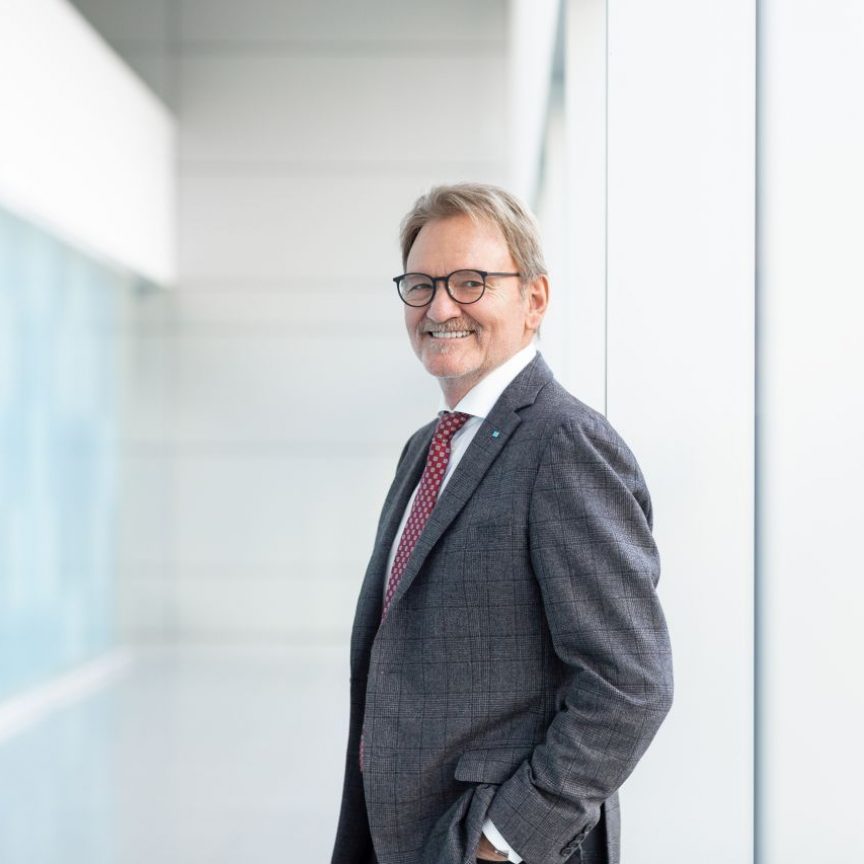
Picture: VDI /Catrin Moritz
Volker Kefer
That might have been slightly exaggerated (laughs). But this statement is based on my own experience. For example, one of my tasks as a member of the Board of Management at Deutsche Bahn was to communicate with and for the general public. It so happens that people at Deutsche Bahn like to talk about what they call “grade-separated junctions” in construction projects. A complicated and incomprehensible word that basically refers to nothing more than a bridge. Why not just say bridge? When dealing with topics in a certain degree of depth, we tend to detach ourselves somewhat from normal reality and speak in a jargon that is no longer comprehensible to most people.
Is it possible to learn to communicate more clearly?
Volker Kefer
Communication is something that needs to be practiced and it should be part of university education. If someone aims to present a complicated issue to a broader audience in a way that is comprehensible, they have to be able to significantly simplify things. Unfortunately, nothing is more challenging than explaining a difficult issue in three sentences. As engineers, we tend to always point out some kind of caveat. When we are asked “Is that correct?” we say “Yes, provided such and such applies or as long as so and so exists as a qualifier.” Most people either don’t understand such relativization or even find it dubious. It gives the impression that the engineer is not quite sure either. If someone is really good, they dare to say yes or no in the end, knowing full well that there are limiting conditions and caveats. That is the whole secret.
Sami Haddadin
This is true. When I was a student at the Center for Digital Technology and Management, we had seminars on presentation technique. Our lecturer gave us a topic that was not part of our field of study and asked us to give a short ad hoc presentation on it. I had been given an offshoring topic and, as a technologist, of course had no idea. I thought very carefully about what I wanted to say, but to be honest felt that I was superficial and that a lot of half-knowledge was involved. However, after the presentation and to my great incomprehension, the course instructor said to me, “Dear Sami, when you speak, we all feel like fools in comparison.” I found that very hard to believe, because I perceived myself to be utterly uninformed. At the same time, I realized that I obviously had to work on my way of communicating. In the meantime, I have to and am also lucky to have many opportunities to communicate a lot, but it’s still not easy for me. I often try to get feedback from my children and my wife beforehand on whether what I am saying can be understood.
Ms. Ramirez, have you experienced challenges like this too when presenting the Hyperloop project to the public?
Sofía Ramirez
It is completely new technology and there is indeed some apprehension. Many people think that humans cannot tolerate the speed. There is this anecdote that in the past people were warned against traveling by train because it was believed that the rapid movements would cause mental unrest in passengers. At that time, the speed was 60 kilometers per hour at best. The TUM Hyperloop does more than 460 kilometers per hour (laughs). We actually have to deal with the fact that we as engineers ourselves don’t yet know everything about the implications of the technology. That’s why it’s only natural for us to look at aspects of feasibility, sustainability, cost-effectiveness and, of course, health compatibility as early as in the development phase. If we make this clear, we are able to meet most people where they are at.
How was it that TUM’s Hyperloop project was so successful? After all, numerous teams from all over the world have participated in the competitions.
Sofía Ramirez
We benefited tremendously from the knowledge that was available at TUM and had massive support from professors and industry partners. But I think that our freedom in the development stage was also a particularly crucial factor. Nobody told us what to do. We always had the freedom to decide for ourselves. A lot of things we didn’t know, a lot of things were new to us, but we always had this freedom to try everything ourselves. That was pretty nice and gave us self-confidence in our own abilities.
Do you think there should be more freedom like this for students at the university?
Sofía Ramirez
Comparing TUM with other universities, for example, in the U.S., we’re doing pretty well. Universities in the U.S. are very expensive and students can’t afford to take a semester off and devote themselves fully to a student project, like we did. But what would be even better, would be if the project was recognized as course credit. Then no one would have to take a semester off. But it was definitely worth it. I would recommend everyone to have this experience.
Sami Haddadin
I would support recognizing such projects as course work. We are now setting up a new international master’s program in Robotics and Artificial Intelligence, which will be largely project-based. Let me illustrate this by using the Cybathlon as an example. This is a competition for people wearing prostheses who, supported by state-of-the-art technical assistance systems, compete against each other in solving everyday tasks. Project teams are challenged to develop their own completely novel prostheses and equip the competitors. This is relatively complex and also costs a lot of money. We have now decided to cover those costs so that our students have the opportunity to participate. And we have made it possible at TUM for the project to be officially recognized as course work.
Sofía Ramirez
That is so cool.
Sami Haddadin
I know, right? (laughs).
Catharina van Delden
I have to say that I have always found TUM to be very progressive in this regard – especially when it came to the development of our business idea and the support we received during the start-up process. We got a lot of practical help in setting up our company, but the most important thing for me was that we had the freedom to develop our ideas and continuously received positive encouragement. When I started studying, I didn’t have any intention of starting a business, but at TUM I was shown that entrepreneurship was a realistic path to take.
Thomas F. Hofmann
This is a core aspect of the entire topic we have been discussing today. We need to encourage our young talent to go their own way and implement their individual visions. As a university, we can and should lend them a helping hand. We can do this by encouraging free thinking across disciplinary divides and by not just letting students memorize what’s in the standard textbooks. We need to point out where there are exciting interfaces between disciplines. And we need to take away their fear of failure and also encourage them, for example, to start their own business if that’s where their path takes them. I believe that this kind of promoting creativity, new ways of thinking, and entrepreneurial spirit, is a key element of the ability to innovate.
We would like to thank you very much for the interesting conversation.
The online meeting is over. One by one, the participants say goodbye to the panel. In the wake of the meeting, the fascinating discussion and the wide range of opinions stimulate further reflection. The participants agreed on how important it is for them personally to take social responsibility and that technology should not be developed just for its own sake. TUM is taking a forward-looking approach to this issue. Many new projects will be launched in the coming months and weeks. TUM wants to transcend boundaries – between disciplines as well as between science and society.
